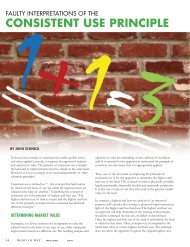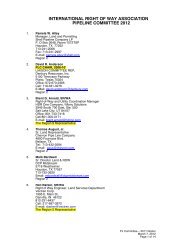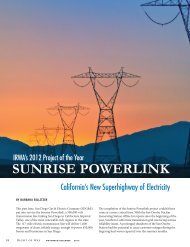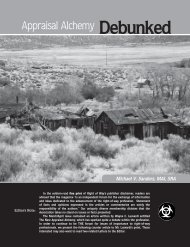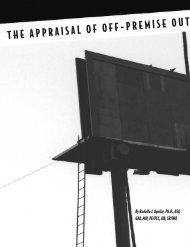The Appraisal of Easements - International Right of Way Association
The Appraisal of Easements - International Right of Way Association
The Appraisal of Easements - International Right of Way Association
- No tags were found...
You also want an ePaper? Increase the reach of your titles
YUMPU automatically turns print PDFs into web optimized ePapers that Google loves.
FEATUREremainder <strong>of</strong> the taking. Sales <strong>of</strong> properties burdened by a similareasement are compared with similar properties not affected by the sametype <strong>of</strong> easement.ALTERNATIVE METHODOLOGIESOn occasion valuation methodologies other than the “before and after”method are advocated both in practice and in appraisal literature. <strong>The</strong>sealternative methodologies have arisen in part from the hectic nature <strong>of</strong>utility right <strong>of</strong> way (telephone, electricity, pipeline, fiber optic, etc.)acquisitions in recent years and some have serious flaws. Three <strong>of</strong> thesealternative methods will be discussed: use <strong>of</strong> easement transactions ascomparables, linear rules <strong>of</strong> thumb, and incorrect use <strong>of</strong> corridorvaluation theory.EASEMENT TRANSACTIONS COMPARABLES — Generally speaking,easement transactions are not reliable for use as comparable data andshould not be used when appraising the impact <strong>of</strong> an easement on theburdened property. Even though the use <strong>of</strong> easement transactions seemsvery straight forward, there are a number <strong>of</strong> reasons why they should notbe used to estimate market value.<strong>Easements</strong> are not economic units in and <strong>of</strong> themselves. An economicunit must stand alone on its own. <strong>The</strong>y are not traded individually on theopen market. A user purchases easements in order to assemble a systemand most easement transactions represent gain to the buyer as opposed toloss in value to the burdened property. Because the buyer is puttingtogether a right <strong>of</strong> way system, many non-realty considerations could beinvolved in an easement transaction including administrative costs,engineering factors, project timing and other business decisions. Forexample, a natural gas supplier facing a contractual deadline might pay aninflated price for a particular easement in order to complete the project.Another example would be when valuing partial acquisitions for a roadwideningproject; sales <strong>of</strong> strips <strong>of</strong> land to the condemnor on other roadprojects are not used as comparable sales. <strong>The</strong> appraisal methodologyshould be consistent regardless <strong>of</strong> the type <strong>of</strong> project.For some types <strong>of</strong> easements, such as those acquired by utilitycompanies for electric, telephone, cable lines and pipelines, there may bean established going rate per pole, per line-mile, per rod, and the like. Inappraising a similar type <strong>of</strong> easement for government acquisitions, theappraisal should not be based on such going rates but should be basedupon the usual “before and after” appraisal method. It therefore goeswithout saying that sales <strong>of</strong> easements based on such measures cannot beconsidered valid comparable sales.<strong>The</strong> use <strong>of</strong> easement sales introduces project influence (an afterscenario) to the before valuation. Any valuation <strong>of</strong> an easement impactshould be in the after situation. In the before scenario, there is noeasement. Using easement transactions as comparables might indicate apre-determined opinion that the proposed easement area represents aneconomic unit (separate highest and best use). <strong>The</strong> probability <strong>of</strong> aneasement being placed on a particular property at the precise locationacross the property in anticipation <strong>of</strong> a project in the future is probablyremote. Accordingly, the reasonable probability component <strong>of</strong> highestand best use is violated.Easement transactions are complex and obtaining all <strong>of</strong> the informationnecessary to make a direct comparison to the subject easement is extremelydifficult. Confirmation by the appraiser <strong>of</strong> the amounts paid for eacheasement along a right <strong>of</strong> way project is very difficult. Even if the salesprices are available, identifying and abstracting the various components <strong>of</strong>each transaction such as land value, damages to the remainder, businessdecision, etc. are hard to obtain. Accordingly, the comparison is usuallyunreliable.Each burdened property is unique. An easement across one propertywill probably reflect a different impact when compared to the impact <strong>of</strong> aneasement acquisition on the subject property. For example, there may havebeen improvements within the easement areas <strong>of</strong> one easement sale andnone in the subject easement area. <strong>The</strong>re may be damages to the remainderas a result <strong>of</strong> the easement on one property and no damages to theremainder on the subject property. <strong>The</strong> highest and best use <strong>of</strong> oneproperty may be different than that <strong>of</strong> the subject whole property.Each easement is unique. For example, one easement may involve a 50-foot right <strong>of</strong> way compared to only 30-feet for the subject easement.Another easement may extend diagonally across one property unlike thesubject easement that may extend along the property boundary. Oneeasement may have a term <strong>of</strong> ten years while the subject easement mayhave an indefinite term.Each user improvement is unique. <strong>The</strong> size <strong>of</strong> the pipeline, the number<strong>of</strong> pipelines allowed, the product, etc. all may differ between one easementtransaction and the facility to be built on the subject easement area. <strong>The</strong>se44 NOVEMBER/DECEMBER 2001 ✦ right <strong>of</strong> way







